新版-人教版七年级英语下册第三单元教案
- 格式:doc
- 大小:86.00 KB
- 文档页数:6
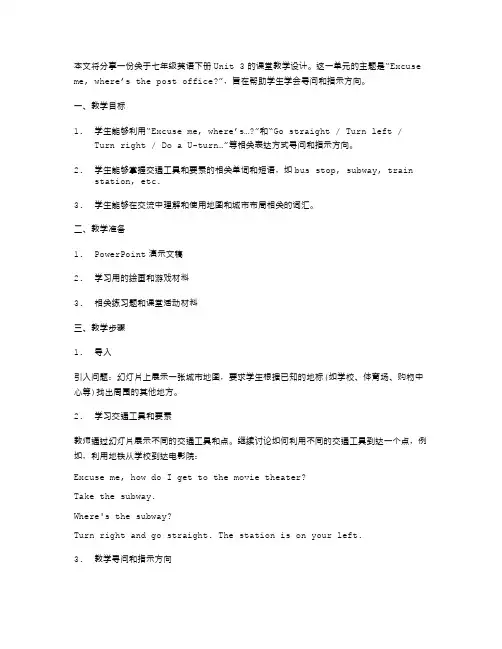
本文将分享一份关于七年级英语下册Unit 3的课堂教学设计。
这一单元的主题是“Excuse me, where’s the post office?”,旨在帮助学生学会寻问和指示方向。
一、教学目标1.学生能够利用“Excuse me, where’s…?”和“Go straight / Turn left /Turn right / Do a U-turn…”等相关表达方式寻问和指示方向。
2.学生能够掌握交通工具和要素的相关单词和短语,如bus stop, subway, trainstation, etc.3.学生能够在交流中理解和使用地图和城市布局相关的词汇。
二、教学准备1.PowerPoint演示文稿2.学习用的绘画和游戏材料3.相关练习题和课堂活动材料三、教学步骤1.导入引入问题:幻灯片上展示一张城市地图,要求学生根据已知的地标(如学校、体育场、购物中心等)找出周围的其他地方。
2.学习交通工具和要素教师通过幻灯片展示不同的交通工具和点。
继续讨论如何利用不同的交通工具到达一个点,例如,利用地铁从学校到达电影院:Excuse me, how do I get to the movie theater?Take the subway.Where's the subway?Turn right and go straight. The station is on your left.3.教学寻问和指示方向教师在幻灯片上展示不同地理位置的照片和地图,提示学生开始学习如何问路和指路。
教师向学生展示如何使用“Excuse me, where’s…?”句型,以及“Go straight / Turn left / Turn right / Do a U-turn…”等表达方式来指示方向。
教师可以与学生分组进行角色扮演,以加强他们的语言进程和提高他们的口语表达能力。
4.练习方向、地图和城市布局相关的词汇通过游戏、图片和绘画等多种形式收集和展示不同的地图和城市布局相关的单词和短语,例如:Bus stop / Subway / Train stationNorth / South / East / WestOn the left / On the right / Across the street / Next to5.面向现实场景的实践通过现实场景的练习加强学生的学习效果。
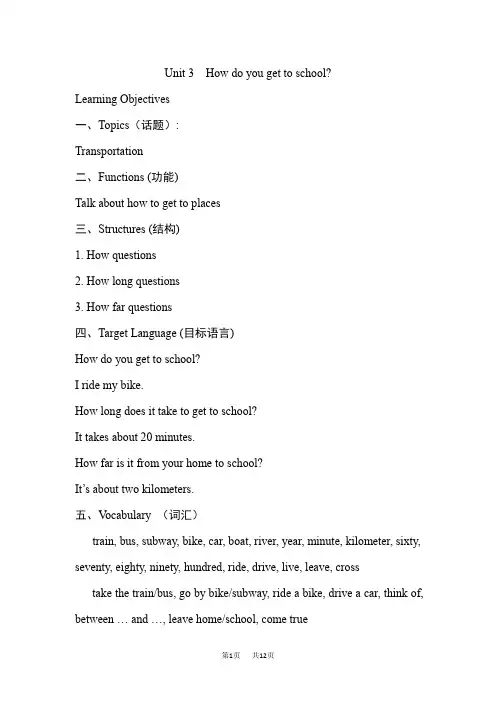
Unit 3 How do you get to school?Learning Objectives一、Topics(话题):Transportation二、Functions (功能)Talk about how to get to places三、Structures (结构)1. How questions2. How long questions3. How far questions四、Target Language (目标语言)How do you get to school?I ride my bike.How long does it take to get to school?It takes about 20 minutes.How far is it from your home to school?It’s about two kilometers.五、V ocabulary (词汇)train, bus, subway, bike, car, boat, river, year, minute, kilometer, sixty, seventy, eighty, ninety, hundred, ride, drive, live, leave, cross take the train/bus, go by bike/subway, ride a bike, drive a car, think of, between … and …, leave home/school, come true六、Skills (技能)Listening for key informationScanning in reading七、Recycling (复习巩固)Numbers 1–30I usually …It is easy to …Thanks for …八、教材分析本单元以How do you get to school?为中心话题,主要运用How long/How far 询问“去某地的交通方式、时间、距离”,简单描述路线。
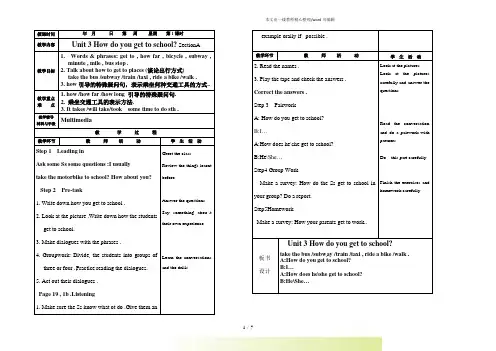
授课时间年月日第周星期第1课时教学内容Unit 3 How do you get to school? SectionA教学目标1. Words & phrases: get to , how far , bicycle , subway ,minute , mile , bus stop .2. Talk about how to get to places (谈论出行方式)take the bus /subway /train /taxi , ride a bike /walk .3. how引导的特殊疑问句,表示乘坐何种交通工具的方式..教学重点难点1. how /how far /how long 引导的特殊疑问句.2. 乘坐交通工具的表示方法.3. It takes /will take/took some time to do sth .教学辅导材料与手段Multimedia教学过程教学环节教师活动学生活动Step 1 Leading inAsk some Ss some questions :I usuallytake the motorbike to school? How about you? Step 2 Pre-task1. Write down how you get to school .2. Look at the picture .Write down how the studentsget to school.3. Make dialogues with the phrases .4. Groupwork: Divide the students into groups ofthree or four .Practice reading the dialogues. 5. Act out their dialogues .Page 19 , 1b .Listening1. Make sure the Ss know what ot do .Give them an Greet the classReview the things learntbefore.Answer the questions.Say something abou ttheir own experience.Learn the conversationsand the drills.example orally if possible .教学环节教师活动学生活动2. Read the names .3. Play the tape and check the answers .Correct the answers .Step 3 PairworkA: How do you get to school?B:I…A:How does he\she get to school?B:He\She…Step4 Group WorkMake a survey: How do the Ss get to school inyour group? Do a report.Step5HomeworkMake a survey: How your parents get to work..Look at the pictures.Look at the picturescarefully and answer thequestions.Read the conversationand do a pairwork withpartners.Do this part carefullyFinish the exercises andhomework carefully.板书设计Unit 3 How do you get to school?take the bus /subway /train /taxi , ride a bike /walk .A:How do you get to school?B:I…A:How does he\she get to school?B:He\She…教学反思授课时间年月日第周星期第2课时教学内容Unit 3 How do you get to school? SectionA 教学目标1.复习基数词及时间的表示方法.2.了解中外文化的差异.教学重点难点1.It takes /will take/took some time to do sth .2. Target language. The use of the drill.教学辅导材料与手段Multimedia教学过程教学环节教师活动学生活动Step 1 Leading in1. Greetings .2. Check the homework .Step 2 Pre –taskPage 20 , 2a.2b&2c .1. Revise the numbers .2. Teach the new word :minute .3. Play the tape for the students to finish Greet the classReview the things learntbefore.Revise the numbers .Listen to the recordingcarefully.2a&2c .Then play again and check theanswers ..4. Go over the dialogue in Page20 ,2d.Step 3 Pre-taskCheck the answer.教学环节教师活动学生活动Page 20 ,Grammar focus .1. Review the grammar box .Ask students to saythe statements and responses .2. Practice reading .Explain the usage of “take” in “take the train”and “take some time to do sth” .activityStep 4 PairworkMake a conversation about how you get toschool. Then practice in pairs.Step5 HomeworkRemember the Grammar Focus .Read the conversationand do a pairwork withpartners.Do this part carefullyFinish the exercises andhomework carefully.板书设计Unit 3 How do you get to school? Numbers: 32 40 41 50 60 70 80 90 100 Phrases:It takes /will take/took some time to do sth .教学反思授课时间年月日第周星期第3课时教学内容Unit 3 How do you get to school? SectionA教学目标1. 复习how far ,how long 引导的特殊疑问句.2. Reading practice.3. Writing practice.4.New words and phrases: town ill worry so much教学重点难点1. Key vocabulary, key phrases2. Target language. The use of the drill.教学辅导材料与手段Multimedia教学过程教学环节教师活动学生活动Step 1 Leading in1.Have Ss make sentences with “take to” .Explain the usage of “take” in “take the train”and “take some time to do sth” .Step 2 While-taskPage 21,3a .1. Pay attention to the speech bubbles .Read thequestions .2. Read the passage by the Ss. Find the answersto the questions and write the answers on thelines .Correct the answers .Step 3 Page 21, 3b .Greet the classReview the things learntbefore.Answer the questions.Say something abouttheir own experience.Learn the conversationsand the drills.教学环节教师活动学生活动1. Show Ss the example in the box .Two studentsread it to the class .2. Pairwork: Make your own conversations usingthe information in the left box.3. Ask some pairs to present the conversations tothe classStep 4 Post-taskPage 21 ,Part 4 .Groupwork.Divide the Ss into groups of three .In each group ,one is A,who look at Page 21.One is B,who look at Page 85,the other is C,who look at Page 86 .Fill in the blanks .The group who fill in the blanks first wins .Step 5 HomeworkWrite the sentences in Part 4 on the exercise books .Look at the pictures. Look at the pictures carefully and answer the questions.Read the conversation and do a pairwork with partners.Read this part carefullyFinish the exercises and homework carefully.板书设计Unit 3 How do you get to school?A:How far is it from your home to school?B:It’s…It takes/took sometime to do something.教学反思时间年月日第周星期第4课时教学内容Unit 3 How do you get to school?. SectionB教学目标1. vocabulary :bus stop bus station train station subwaystation .2. 能力目标:谈论上学的全过程。
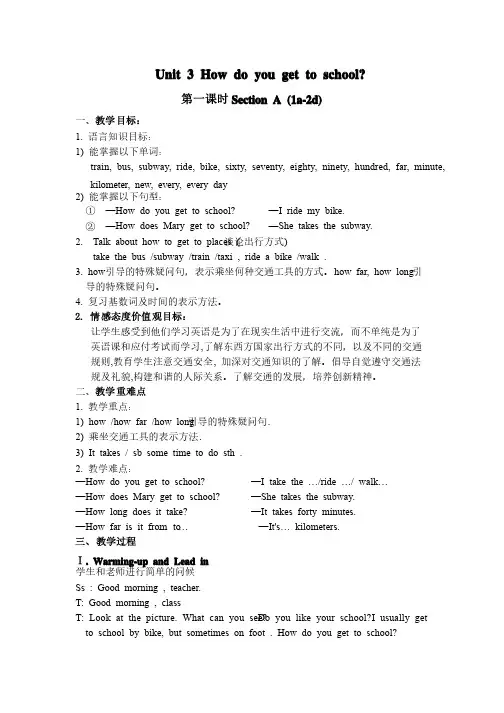
Unit 3 How do you get to school?第一课时Section A (1a-2d)一、教学目标:1. 语言知识目标:语言知识目标:1) 能掌握以下单词:能掌握以下单词:train, bus, subway, ride, bike, sixty, seventy, eighty, ninety, hundred, far, minute, kilometer, new, every, every day 2) 能掌握以下句型:能掌握以下句型:① —How do you get to school? —I ride my bike. ② —How does Mary get to school? —She takes the subway. 2. Talk about how to get to places (谈论出行方式) take the bus /subway /train /taxi , ride a bike /walk . 3. how 引导的特殊疑问句,表示乘坐何种交通工具的方式。
how far, how long 引导的特殊疑问句。
导的特殊疑问句。
4. 复习基数词及时间的表示方法。
复习基数词及时间的表示方法。
2. 情感态度价值观目标:让学生感受到他们学习英语是为了在现实生活中进行交流,而不单纯是为了英语课和应付考试而学习,了解东西方国家出行方式的不同,了解东西方国家出行方式的不同,以及不同的交通以及不同的交通规则,教育学生注意交通安全, 加深对交通知识的了解。
倡导自觉遵守交通法规及礼貌,构建和谐的人际关系。
了解交通的发展,培养创新精神。
二、教学重难点1. 教学重点:教学重点:1) how /how far /how long 引导的特殊疑问句. 2) 乘坐交通工具的表示方法. 3) It takes / sb some time to do sth . 2. 教学难点:教学难点:—How do you get to school? —I take the …/ride …/ walk… —How does Mary get to school? —She takes the subway. —How long does it take? —It takes forty minutes. —How far is it from … to … —It's It's…… kilometers. 三、教学过程Ⅰ. Warming-up and Lead in 学生和老师进行简单的问候学生和老师进行简单的问候Ss : Good morning , teacher. T: Good morning , class T: Look at the picture. What can you see? Do you like your school? I usually get to school by bike, but sometimes on foot . How do you get to school? Ss 按实际情况作答按实际情况作答S1: I ride my bike. S2: I go by bus. S3: ………T: V ery good. You’re clever. Let’s learn Unit 4 Section A. 之后板书:之后板书:“Unit 4 How do you get to school?”Ⅱ. Presentation 1. T: If you are here, but your school is in Shanghai. How do you get to school? Ss: I take the bus /plane/ boat / ship / car / taxi I ride a bike / motorbike T: Do you know any other way? 2. Teacher shows pictures on the big screen .归纳出行方式和常用短语. Ask some questions about how you get to…? (让学生积极主动的思考想象总结,多媒体增加趣味性,加强直观性,效果事半功倍) 3. Show a picture about Part 1, on the screen. Point at girls or boys in the picture. Ask students to answer and write in the blanks. S1 : How does he / she go to school? S2 : He / She … …Ⅲ. 1a T: Look at the picture on your book. Match the words with the picture. (学生们完成1a 的学习任务,然后校对答案) Ⅳ. Listening 1. Make sure the Ss know what to do. Give them an example orally if possible. 2. Read the names in the box. 3. Play the tape and check the answers. Ⅴ. Pair work Ask two students to read the dialogue in the speech bubbles to the class. Then ask students students to to to work work work in in in pairs. pairs. pairs. Ask Ask Ask and and and answer answer answer how how how students students students get get get to to to school school school in in in the the picture. Finally ask some pairs of students to present their conversations to the class. Ⅵ. Listening 1. 1. Revise Revise Revise the the the numbers, numbers, numbers, first, first, first, zero~nine, zero~nine, zero~nine, next, next, next, ten~nineteen, ten~nineteen, ten~nineteen, then, then, then, twenty, twenty, thirty, forty forty……finally, twenty-one, twenty-two… Teach the new word "hundred". 2. Play the tape for the students to finish 2a. Then play again and check the answers Ⅶ. Presentation Section A (1a-2d) 1. —How do you get to school? —I ride my bike? —How does Mary get to school? —She takes the subway. 2. 表达“几十” 个位数字+ty twenty, thirty, 一定要用连字符 twenty-five, sixty-nine 表达“几十几” 一定要用连字符hundred one hundred, two hundred 3. ① How does Jane get to school? ② How far is it from home to school? ③ How long does it take to get to school from her home? 课后反思:引入环节可以先让学生以小组活动为主要练习方式,引入环节可以先让学生以小组活动为主要练习方式,让学生讨论他们让学生讨论他们所知道的交通工具,所知道的交通工具,并把它们画出来,并把它们画出来,并把它们画出来,由小组长汇总,由小组长汇总,由小组长汇总,并填表向全班同学展示讨并填表向全班同学展示讨论结果,论结果,全班评选出哪一组知道的交通工具多,全班评选出哪一组知道的交通工具多,全班评选出哪一组知道的交通工具多,并看谁画得棒。
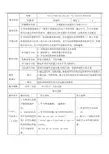
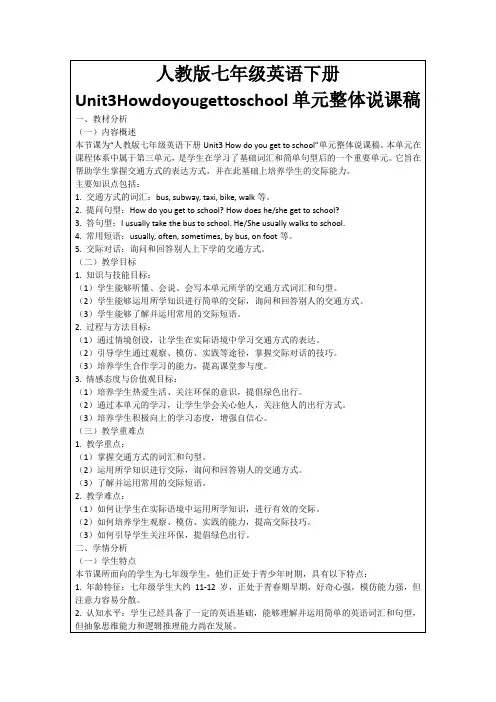
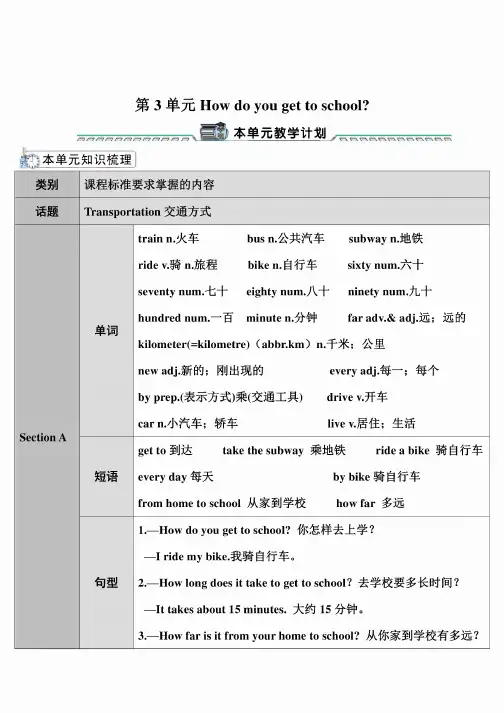
第3单元How do you get to school?本单兀教学计划弋,本单元知识梳理类别课程标准要求掌握的内容话题Transportation交通方式Section A 单词train n.火车bus n.公共汽车subway n.地铁ride v.骑n.旅程bike n.自行车sixty num.六十seventy num.七十eighty num.八十ninety num.九十hundred num.一百minute n.分钟far adv.&adj.远;远的kilometer(-kilometre)(abbr.km)n.千米;公里new adj.新的;刚出现的every adj.每一;每个by prep.(表小方式)乘(交通工具)drive v.开车earn.小汽车;轿车live v.居住;生活短语get to到达take the subway乘地铁ride a bike骑自行车every day每天by bike骑自行车from home to school从家到学校how far多远句型1.—How do you get to school?你怎样去上学?一I ride my bike.我骑自行车。
2.一How long does it take to get to school?去学校要多长时间?—It takes about15minutes.大约15分钟。
3.—How far is it from your home to school?从你家到学校有多远?一Ifs only about two kilometers.大约只有2千米。
4.H ave a good day at school.祝你在校过得愉快。
5.D oes Jane walk to school?简步行去学校吗?Section B 单词stop n.车站;停止cross v.横过;越过river n.河;江many adj.&pron.许多villagen.村庄;村镇between prep.介于....之间bridge n.桥boat n.小船year n.年;岁afraid adj.害怕;畏惧like prep.像;怎么样villager n.村民leave v.离开;留下dream n.梦想;睡梦v.做梦true adj.真的;符合事实的ropeway n.索道短语think of认为;想起between...and...在....和....之间come true实现;成为现实have to不得不;必须句型1.Mary wants to know what he thinks of the trip.玛丽想知道他认为这次旅行怎么样。
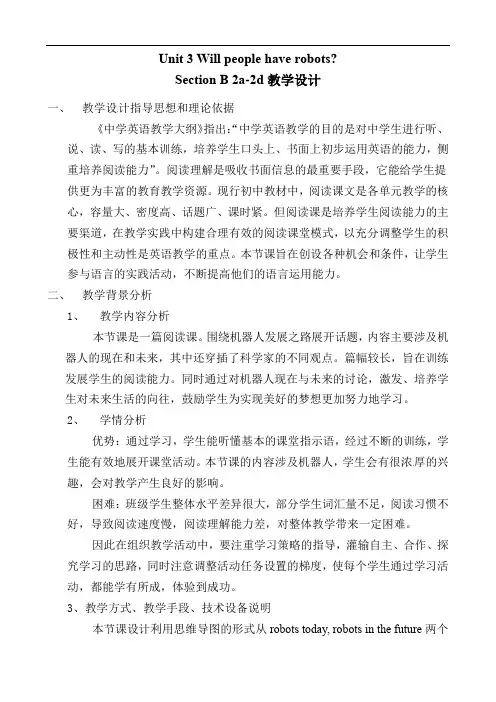
Unit 3 Will people have robots?Section B 2a-2d教学设计一、教学设计指导思想和理论依据《中学英语教学大纲》指出:“中学英语教学的目的是对中学生进行听、说、读、写的基本训练,培养学生口头上、书面上初步运用英语的能力,侧重培养阅读能力”。
阅读理解是吸收书面信息的最重要手段,它能给学生提供更为丰富的教育教学资源。
现行初中教材中,阅读课文是各单元教学的核心,容量大、密度高、话题广、课时紧。
但阅读课是培养学生阅读能力的主要渠道,在教学实践中构建合理有效的阅读课堂模式,以充分调整学生的积极性和主动性是英语教学的重点。
本节课旨在创设各种机会和条件,让学生参与语言的实践活动,不断提高他们的语言运用能力。
二、教学背景分析1、教学内容分析本节课是一篇阅读课。
围绕机器人发展之路展开话题,内容主要涉及机器人的现在和未来,其中还穿插了科学家的不同观点。
篇幅较长,旨在训练发展学生的阅读能力。
同时通过对机器人现在与未来的讨论,激发、培养学生对未来生活的向往,鼓励学生为实现美好的梦想更加努力地学习。
2、学情分析优势:通过学习,学生能听懂基本的课堂指示语,经过不断的训练,学生能有效地展开课堂活动。
本节课的内容涉及机器人,学生会有很浓厚的兴趣,会对教学产生良好的影响。
困难:班级学生整体水平差异很大,部分学生词汇量不足,阅读习惯不好,导致阅读速度慢,阅读理解能力差,对整体教学带来一定困难。
因此在组织教学活动中,要注重学习策略的指导,灌输自主、合作、探究学习的思路,同时注意调整活动任务设置的梯度,使每个学生通过学习活动,都能学有所成,体验到成功。
3、教学方式、教学手段、技术设备说明本节课设计利用思维导图的形式从robots today, robots in the future两个方面梳理文章脉络,并指导学生用思维导图来复述文章,锻炼学生的归纳总结和语言表达能力。
运用“讨论-限时自读-导读-复读-讨论”的基本课堂教学模式,设计学生学习活动。
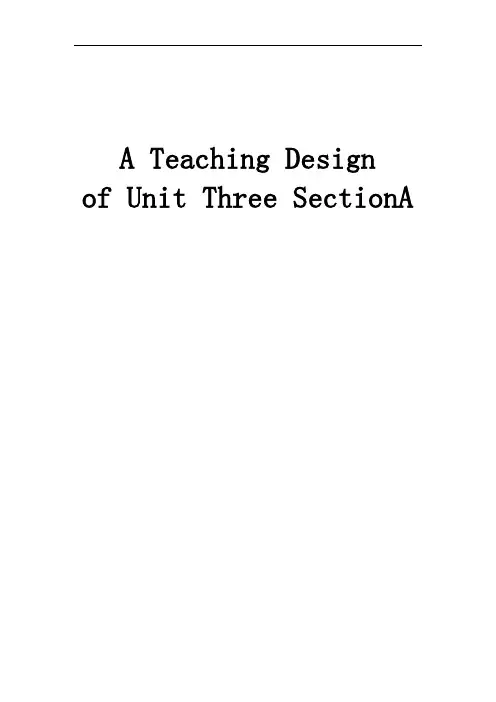
A Teaching Designof Unit Three SectionAI. 学习目标Learning objectives:After this class, students are expected to:知识目标: Listen to and understand, talk about, read, and write different ways of transportation, and three questions:How do you get to …?How long does it take you…?How far is it from…to…?能力目标:Finish listening tasks.Ask and answer questions about how to get to places, howlong it takes and how far it is.Can make a survey and write a report, with the help ofgroup members.(The report may be left as homework ifunfinished)情感目标:Choose the right way of transportation if possible.II.学习重难点What will be difficult to learn:1.How to ask and answer the three questions:How do you get to …?How long does it take you…?How far is it from…to…? Especially the last two.2.Make a survey and write the report.III.学习步骤learning procedures:Activity 1 lead-inBefore theclass, listen to an English song and answer the question: Whatvehicles can you find in the video?Step1. Warm up and led inActivity2 listening (learn“how do you get to school?”)Step1 Before listeningYou know I drove the car to school. How do you get to school?Possible answers:I get to school on foot. You can also say: You walk to school.It is good exercise.I get to school by bike. You can also say:You ride a bike to school.It is good exercise and you save your time.I get to school by bus. You can also say:You take the car to school.You can save your time.Does anyone take the train to school?Does anyone take the subway to school? Do you know “subway”.A subway is like a train but goes under the ground.Take our your book and look at 1a. match the words with the pictures. Please note “subway”.Step2While listeningIn the picture, can you see some boys and girls? Do you know their names? Let’s listen to a conversation and you will know. Please listen and write the numbers.Let’s read before listening:Bob Mary John Paul Yanglan JimLet’s check the answers.Step3 After listeningHow do they get to school?Bob take the trainMary take the busJohn take the subwayPaul ride a bikeYang LanJimNow ask and answer in pairs.Activity3 Learning numbersI am from Dongying. How do I get to school? I drive the car to school. The four numbers below all have something to do with my trip. Can you guess their meanings?1 20 59 1101. I drive a car.20. I saw twenty red lights.59.It is fifty-nine kilometers from Dongying toHekou, and I drove my car here.110.It takes one hundred and twenty-eight minutes. Activity4 listening (learn“how long does it take…?” and “how far is it from…to…”)Step1 Before listeningNow we are going to listen to a conversation between Tom and Jane. Please listen and complete the chart. Look at the chart and let’s read: How howlong(minutes) how far(kilometers)Note: you will have to write down the numbers.Step2 While listeningListen and complete the chart.Listen again and check your answers.How long does it take?How far is it from…to …?Step3 After listening1.let’s sing a song by Mr. Cui.How far is it? How far is it?From your home, to your school?How long does it take you? How long does it take you?To get there?To get there?Activity5 Role-play the conversation(a combination of what’s been learned)1.Read and complete the chart.Now please make a conversation in pairs(studentA is Jane and studentB is Tom) with the help of the chart.How do you get to school?How long does it take (you)?How far is it from…to …?Act out2.Listen to the tape and follow.3.Let’s role-read. Boys read Lisa and girls read Jane.Please exchange.4.Do you have any questions?the bus ride/It is good exercise/Activity6 Making a surveyAsk and answer in groups of four, can complete the chart:Af ter the survey, each group report like this:A :How do you get to school? B: Well, I usually walk but sometimes I take the bus. A: How long does it take? B: It takes about … minutes to walk and … minutes by bus. A: How far is it from your home to school? B: It’s about … kilometers.In our group, A walks to school. It takes him twenty minutes. It is 2miles from his home to school. B rides a bike to school. It takes him ten minutes. It is one kilometer from his home to school…….I like walking to school, because it is good exercise.Activity7 Sum upActivity8 Assign homework.Required(必做): go back home and ask your parents:How do you get to work?How long does it take (you)…?How far is it from …to…?And write a report to share with your classmates tomorrow. Optional(选做): search the internet and find more ways to go to a place: You may take the spaceship to the moon one day!!初中英语人教版七年级下册第三单元第一课时学情分析下面我对于本节课的授课班级的学情做一分析。
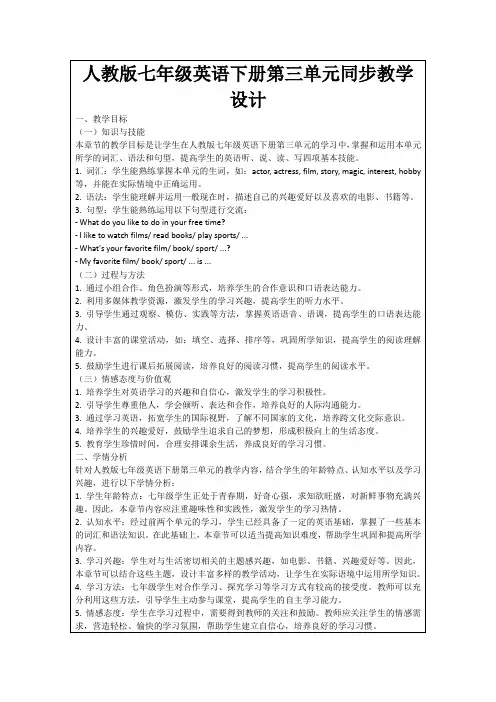
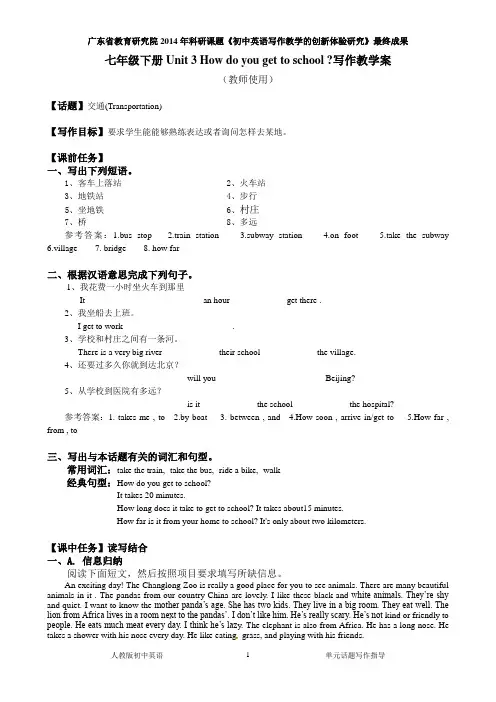
七年级下册Unit 3 How do you get to school ?写作教学案(教师使用)【话题】交通(Transportation)【写作目标】要求学生能能够熟练表达或者询问怎样去某地。
【课前任务】一、写出下列短语。
1、客车上落站2、火车站3、地铁站4、步行5、坐地铁6、村庄7、桥 8、多远参考答案:1.bus stop 2.train station 3.subway station 4.on foot 5.take the subway 6.village 7. bridge 8. how far二、根据汉语意思完成下列句子。
1、我花费一小时坐火车到那里It ____________ ____________ an hour ____________ get there .2、我坐船去上班。
I get to work ____________ ____________.3、学校和村庄之间有一条河。
There is a very big river ____________ their school ____________ the village.4、还要过多久你就到达北京?____________ ____________ will you____________ ____________ Beijing?5、从学校到医院有多远?____________ ____________ is it ____________ the school ____________ the hospital?参考答案:1. takes me , to 2.by boat 3. between , and 4.How soon , arrive in/get to 5.How far , from , to三、写出与本话题有关的词汇和句型。
常用词汇:take the train,take the bus,ride a bike,walk经典句型:How do you get to school?It takes 20 minutes.How long does it take to get to school? It takes about15 minutes.How far is it from your home to school? It's only about two kilometers.【课中任务】读写结合一、A. 信息归纳阅读下面短文,然后按照项目要求填写所缺信息。
Unit 3 How do you get to school?全单元教案课题:Unit3 Section A (1a-1c)教学目标:语言能力、思维品质、文化品格、学习能力语言能力:1、单词:get to, train, bus, subway, take the subway, ride, bike, ride a bike2、句型:—How do you get to school? →I walk/ ride my bike.思维品质:通过听、说等一些活动培养良好的听力习惯和能力,再通过通过独学和小组合作,学会使用本单元重点句型。
文化品格:1、通过互相谈论如何去上学,增进同学之间的了解和友情。
2、了解英语国家学生的学习生活,增强跨文化交际的意识。
学习能力:通过对话练习和小组合作,能够进行角色扮演并创编对话。
教学重点:1.单词:get to, train, bus, subway, take the subway, ride, bike, ride a bike2.句型:—How do you get to school? →I walk/ ride my bike.教学难点:1.熟练运用所学的词汇、句型表达和交流信息。
2.正确运用本课中所学的表示交通方式的短语,表述自己如何去上学。
德育渗透:正确的表达如何去某地。
教学准备:PPT课件教学时间:一课时教学过程:一、复习巩固,预习检测(时间分配:5分钟)让学生做根据简笔画猜交通工具的游戏进行热身。
教师在黑板上画出某种交通工具的一部分,然后让学生猜是哪一种交通工具,看谁猜得既对又快。
(游戏的目的是活跃课堂气氛,充分调动学生学习的积极性,培养学生学习英语的兴趣;同时达到巩固旧知识、进而引出要学习的新知识的目的。
)For example:T:I will draw some kinds of transportation on the blackboard. Can you guess what they are?When you give me the correct answer,I will write the words on the blackboard.(教师画公共汽车、火车、自行车、地铁等交通工具,让学生去猜。
Unit 3 How do you get to school?教案Part 1:Teaching design (第一部分:教学设计)Structures: How questions; Affirmative and negative statementsTarget language:How do you get to school? I take the bus.How long does it take? It takes 20 minutes.How far is it? I t’s 10 miles.Vocabulary: get to, how far, bicycle, subway, car, train, bus stop, train station, bus station, subway station, minute, kilometer, mile, transportation, calendarLearning strategies: Personalizing; I nferring vocabularySECTION AGoals●To learn to use How questions, affirmative and negative statements●Lean to talk about how to get to places, how long it takes to go to places, and how far theplaces are●To talk about kinds of transportationProceduresWarming up by talkingHello, everyone! What’s the weather like today? It’s a sunny day with a gentlebreeze. It’s comfortable. So this morning I come to school by bike. It took menearly 50 minutes. You know I live far from school. I often take buses to comehere. But it takes me more than an hour. What about you? Today, let’s talkabout how you go from one place to another. And wewill talk about the time it takes to get to places and how far it is between twoplaces.1a Looking and writingOpen your book at page19. Look at the picture carefully and read thedialogue. Then please write how the students in the picture get to school inSample answers:1. take the subway2. ride a bike3. take the bus4. take the train5. walk(on foot)6. take a boat7. take a taxi 8. go in a parent’s car1b Listening and writingLook at the picture again. How do students get to school? Let’s listen toa conversation between two people talking about this. Listen carefullyand write the number of the name in the white box next to the student.Please do it individually. Then let’s check the answer.Answers:1. Bob takes the train.2. Mary takes the subway.3. John takes the bus.4. Paul walks.5. Yang Lan walks.TapescriptA: How do Bob and Mary get to school?B: Bob takes the train and Mary takes the subway.A: How does John get to school?B: He takes the bus.A: How do Paul and Yang Lan get to school?B: They walk. Look, there they are waling now!Now read the tapescript, shadow the how questions and underling the expressions.1c Doing pairworkPlease read the dialogue on page 19 in the box. And make your own conversations about how the’ll ask some pairs to say their dialogue. Sample dialogueA: How does Bob get to school?B: He takes the train.A: Does John take the train to school, too?B: No. He takes the bus.A: What aboutMary and Paul?B: Paul walks,and Mary takes thesubway.A: And Yang Lan walks, does she?B: Yes, she does.2a Listening and repeatingListen to these numbers and repeat. Please pay attention to the pronunciation.Tapescript32, 40, 50, 60, 70, 80, 90, 100forty-six 46 thirty-three 33 seventy-two 72one hundred and five 105 fifty-eight 58 ninety-nine 99sixty-one 61 eighty-four 84Now please look at the five transportation pictures. And we’ll listen to two conversations. The people are talking about how students get to school and how long it takes. Listen carefully and put a checkmark to show the kinds of transportation they talk about. Check your answer.40 minutes 35minutes25minutes10 minutesListen carefully again and match the time with the kinds ofTapescriptConversation 1Boy: How do you get to school?Girl: I take the train.Boy: How long does it take?Girl: Oh, around forty minutes. How aboutyou?Boy: I take the subway.Girl: How long does that take?Oh, around thirty-five minutes.Conversation 2Girl: How do you get to school, Tom?Tom: I ride my bike.Girl: How long does it take?Tom: It takes around twenty-five minutes.Tom: How do you get to school?Girl: I walk.Tom: And how long does that take?Girl: It only takes ten minutes.Look at the sentences on the board. “They take the train. It takes about forty minutes.”“Take the train” means to ride the train. And we also use “take” to talk about a length of time. For example, it takes me 20minutes to get to school. So we use the same word, take, in two different ways. Now read the tapescript, shadow the how questions and underling the expressions.2d Doing pairworkNow please make your own conversations about how you get to school and how long it takes.Example:A: How do you get to school?B: well, I usually walk but sometimes I take the bus.A: How long does it take?B: It takes about 25 minutes to walk and 10 minutes by bus. What about you? A: I get to school by bike, sometimes I take my father’s car.B: Oh, how long does it take?A: It takes around 40 minutes by bike and 15 minutes by car.3a Reading and writingSo far you have learned to talk about how you get to school and how long it takes.The passage you will learn in this part tells us something about Li Lei. Pleaseread the questions about Li Lei in the speech bubbles. Then read the passage andwrite the answers to the questions on the line. You should complete the activityindividually.1How does he 2 How long does 3 How far is it fromget to school? it take? his home to school?By bike and It usually takes About 10 kilometers.by bus. about 35 minutes.Now read the passage following the tape sentence by sentence. Please pay attention to the pronunciation and intonation of the native readers and try to imitate them. Then draw lines under the useful phrases and structures.Lin Fei’s home/ is about 10 kilometers /from school. He gets up /at six o’clock/ every day, showers, and has a quick breakfast. Then/ he leaves for school/ at around six-thirty. First, he rides his bicycle/ to the bus station. That takes about ten minutes. Then/ the early bus/ takes him to school. The bus ride/ usually/ takes about 25 minutes.school? What time do you get up? How do you get to school? Let’s ask some students to say something about you.3b Doing pairworkLook at the pictures on page 21. Can you name each form of transportation? They are easy to you. Read the time and distance that goes with each form of transportation. Pay attention to “mile”, which is a common measure of distance in some western countries. (1 mile=1.6 kilometers). Read the example dialogue in the box.A: How do you get to school?B: I take the train.A: How far is it from your home to school?B: It’s eight miles.A: How long does it take you to get from home toSchool ?B: It takes 35 minutes.A: How do you get to school?B: I walk.A: How far is it from your home to school?B: It’s two miles.A: How long does it take you to get from home to school ?B: It takes 40 minutes.A: How do you get to school?B: I take the bus.A: How far is it from your home to school?B: It’s four miles.A: How long does it take you to get from home to school?B: It takes 15 minutes.4 Talking and writingWell done everyone! Now let’s play a game: Info Gap Race! This time you work in groups of three. You decide which one is A, which one is B and which one is C. Please read the instruction. You ask each other questions to learn information for your chart, and then write the answers on the chart in your book. Don’t look at others’ pages please. The first group to fill in all the blanks is theWho How How long How far1. Maria bus twenty minutes five miles2. John bike ten minutes six miles3. Liu Pei subway fifteen minutes eight milesC:How does Maria get to school?A: She takes the bus. How long does it take Maria to get to school?B: It takes her twenty minutes. How far is it from her home to school?C:It’s five miles.Closing down by asking and answering(using the useful information learned in this part)*How do you get to school?*I usually walk, but sometimes I take the bus.*How long does it to take you to get from your home to school?*It takes 25 minutes.*How far is it from your home to school?*It’s around 4miles. A bus station Section BGoals●To learn to use: bus stop, train station, subway station●To learn to talk about how to get to places further.ProceduresWarming up by asking some individuals questionsHow does Li Lei get to school? First, he rides his bicycle to the bus station. Then he takes the early bus to school. Do you know the bus station? It’s a place where trains stop here. Today we’ll study some other “stations”.1a Looking and matchingLook at the four phrases on the top of page 22 and read them loudly. Then match the words withAnswers: 1. b bus stop 2. a train station 3. c bus station 4. d subway station1b Doing pairworkRead the dialogue in the box first. Then suppose you use two kinds of transportation to get to school. Now make your own dialogues to tell your partner how you get to school, using theSample dialogue:A: How do you get to school?B: Well, I ride my bike to the subway station. Then I take the subway. What about you?A: First, I walk to the bus stop. Then I take the bus to school.A: How does your father get to his school?B: Well, he walks for ten minutes to Bus No. 11. He takes the bus and gets off at Da Yingpan. Then he walks again for five minutes to his classroom.2a Listening and checkingOK, now. Let’s listen to the conversation between Tina and Thomas. What does Thomas want to know about Nina? Here is a list of information that Thomas wants to know. I’ll ask some students to read lines to the class. Then listen carefully and put a checkmark in front of each thing thatThomas wants to know…√where Nina lives.how far from school she lives.how long it takes Nina to get to school.√how she gets to school.what she thinks of the transportation.2b Listening and checkingLook at the pictures on page 22 with a blank line in front of each. They show the ways of how to get to school. Which one is Nina’s? Listen carefully and put a checkmark next to the picture that shows how Nina gets to school.1.—to ride a bike to the subway—to take the subway tothe bus—to walk from the bus stop to the school2.√to walk to the bus—to take the bus to the subway—totake another bus after the subway—to walk from the busTypescriptThomas: Where do you live, Nina?Nina: New Street.Thomas: So, how do you get to school?Nina: Well, first I walk to the bus stop.Thomas: Uh-huh.Nina: I take a bus to the subway station. Then I take the subway.Thomas: Yeah…Nina: Next I take a bus to the bus stop on 26thStreet. Finally I walk.You may turn to the tapescript to read it, underlining theexpressions and shadowing the how questions.2c Doing groupworkNow make your conversations about how Nina gets to school in groups of four. You can use the pictures in activity 2b. Pay more attention to the sentence starters: S he…; Next, she…; Then, she…Sample dialogue:A: How does Nina get to school?B: She walks to the bus stop.C: Next, she takes a bus to the subway station.D: Then she takes another bus to the bus stop on 26th street after the subway.A: Finally she walks to school.Now let’s ask some of you to say your descriptions to the class.3a Reading and writingNow you can say something about how you get to school.Do you want to know how students around the world get to school? Read the article on page 23, and then decide if the statements are true or false in your exercise book.Check the answers:T 1. In North America, not all students take the bus to school.T 2. Other parts of the world are different from the United States.F 3. In Japan, the three most popular ways of getting to school are bus, train and bike. (Students take trains, or walk, or ride bikes)F 4. In China, bikes and buses are the most popular means of transportation. (It depends on where you are)T 5. Students in Hongshanhu and Kaishandao have to take a boat to get to school.Read the article once again, this time, to slash/ the sentences, underline the useful expressions in it and shadow the connectives. After school, you are going to write them down in your notebook. How do students around the world get to school?In North America, most students/ go to school/ on the school bus. Somestudents/ also walk/ or ride bikes to school. In other parts of the world,things are different. In Japan, most students/ take trains to school,although others also walk/ or ride their bikes. In China, it depends on /where you are. In big cities, students usually ride bikes to school/ or take buses. And in places/ where there are rivers and lakes, like Hongshanhu and Kaishandao, students usually go to school/ by boat. That must be a lot more fun/ than taking a bus!3b Reading and writingLook at the chart. Then read the article and fill in the blanks. You can findthe answers in the chart. Please complete the activity individually.How do the students get to Garden High School?At Garden High School, most students ride their bikes to school. Many students walk. Some students drive. Other students take the bus. A small number of students take the subway.3c WritingJust now we filled in an article about how students get to Garden High School. What about you?How do students in our class get to school? Let’s make a survey and listyour ideas on the board. You can use the words and numbers to write apassage about how students in our class get to school.Sample passage:In my class, most students ride their bikes to school. Many students go to school on foot. Some students live far from school, so they go to school by bus. A few students take their parents' car to school.At Taiyuan Wuzhong, most students live at school. They just walk to their classroom. So they don’t ride their bikes to school. Many students play on the playground in the early morning. Some students play football. Some read aloud their English texts. But at the same time, other students in other schools have to take the bus, ride the bike, to hurry to their schools.4 Making a surveyNow turn to page 82, please. Look at the chart. Read the heading and the phrases listed below.Please complete the chart in ten minutes. You can go around the class and ask questions to find out the answers. Look at the dialogue in the box next to the chart. You can ask questions like this.Find someone who…Nameslives 10 miles away from school.walks to school.takes a bus to school.takes more than an hour to get to school.ride s a bike to school.takes the subway to school.takes less than ten minutes to get to school.Do you remember Nina? How does she get to school? How do students around the world get to school? Please tell me in your own words. And I will also ask some of you to say something about themselves. Who will be the first to have a try?SELF CHECKGoals●To revise the vocabulary introduced in the unit●To practice writing skillProcedures1 Filling the blanks and making sentencesLook at part 1 on page 24. Fill in the blanks with the words given to you. Change the form of the word if necessary.Check the answers:1.How do you get to school in the morning?2.What do you think of the transportation in your town?3.When it rains I take a taxi.4.How far do you live from the bus station?5.I like to ride my bike on the weekend.Now make your own sentences with the words. I’ll ask some students to write the answers on the1.When will you get to Beijing?2.I cannot think of any good methods to learn English.3.I take a plane to go to my school in Shanghai.4.My teacher lives close to the school.5.I never ride a bike in life. But I like riding horses sometimes.Saturday SundayMorning: go to visit Mt. WutaiMorning: take a bus around the city, goshopping at supermarketsAfternoon: visit Jinci Afternoon: go around Pingyao City Evening: watch Jinju at a therter Evening: fly home from TaiyuanJust for fun!Let’s sing a song in English.Three Blind MiceThree blind mice, see how they run!They all ran after the farmer's wife,Who cut off their tails with a carving knife,Did you ever see such a thing in your life,As three blind mice?Part 2: Teaching resources(第二部分:教学资源)I. Background reading1.Traffic in EnglandWhen you are in England, you must be very careful in the streets because the traffic drives on the left.Before you cross a street, you must look to the right first and then the left.If the traffic lights are red, the traffic must stop. Then people on foot can cross the road carefully. If the traffic lights are green, the traffic can go. People on foot mustn't cross. In the morning and in the evening when people go to or come from work, the streets are very busy. Traffic is the most dangerous then.When you go by bus in England, you have to be careful, too. Always remember the traffic moves on the left. So you must be careful. Have a look first, or you will go wrong.In many English cities, there are big buses with two floors. You can sit on the second floor. From there you can see the city very well. It's very interesting!III. Word studies (词语学习)1.takev.1.抓住拾起get hold of something or someone; pick something up: Please take my hand. 请拉住我的手。
新人教版七年级英语下册教案课堂能否进行高效率授课,学生与老师之间能否做到默契配合,教师能否让一节课的内容合理分布在课堂的每一个细节,这些都有赖于教师的教案设计是否符合学生的整体情况。
下面是小编为大家精心整理的新人教版七年级英语下册教案,仅供参考。
新人教版七年级英语下册教案(一)Unit 1 Section B (3a-Self Check)教学目标:1. 语言知识目标:1) 复习询问或谈论自己或对方在某一方面的能力和特长,讨论参加某一个俱乐部。
2) 能够综合运用所学的知识,就自己的熟悉的内容来介绍自己或他人所俱有的能力及特长;3) 总结回顾一些常见的一些表达人们能力的词汇,并能进行分类记忆。
2. 情感态度价值观目标:1) 能了解自己的一些特长,并运用自己的一技之长为他人或社会做一些有益的事情。
2)新人教版七年级英语下册教案(二)教学重难点1. 教学重点:1)2)能运用自己所学的相关英语语言知识,模仿所学过的相关材料来制作简单的广告。
2. 教学难点:的广告。
新人教版七年级英语下册教案(三)教学过程Ⅰ. Warming- up and revision1. Have a dictation of the new words and expressions.2. Let some Ss retell what Peter, Alan and Ma Huan can do.3. Let some Ss to read the three ads again.Ⅱ. Presentation1. T: Who's he?Ss: He's Liu Huan.T: What does he do?Ss: (Help Ss to answer) He's a famous musician.Write the words musician on the Bb.music 音乐→ musician音乐家拓展: teach教→teacher老师Ⅲ. Practice1. T: Next week we'll have a music festival. So we need some musicians to help with the music festival. I wrote an ad the box.2.Ⅳ. Writing3. 2b或3a中的广告的样子来写。
七年级英语下册Unit 3《Don't eat in class》教案人教版一、教学目标1. 知识目标a. 能够听懂、会说、会读本课的生词和短语:classroom, library, teacher's office, puter lab, science lab, don't eat in class, read a book, write on the board等。
b. 能够理解并在适当的情境中运用一般现在时的否定句和疑问句。
2. 能力目标a. 能够用英语简单描述学校中的不同场所和禁止做的事情。
b. 能够听懂、会说、会读关于学校规则的对话。
3. 情感目标a. 培养学生的团队协作精神,使他们意识到遵守学校规则的重要性。
二、教学重难点1. 重点:能够运用一般现在时的否定句和疑问句进行交流。
2. 难点:正确运用一般现在时的否定句和疑问句描述学校规则。
三、教学方法1. 情境教学法:通过设定学校场景,让学生在真实情境中学习英语。
2. 交际法:通过小组活动,让学生在实际交流中掌握英语。
3. 任务型教学法:通过完成具体任务,让学生在实践中学习英语。
四、教学步骤1. 热身(5分钟)a. 教师与学生用中文进行简单的对话,询问学生对本课内容的预习情况。
b. 学生进行简单的自我介绍,介绍自己的学校和生活。
2. 导入(10分钟)a. 教师向学生介绍本课的主题:学校规则。
b. 教师引导学生思考并讨论学校中的禁止做的事情。
3. 课堂讲解(15分钟)a. 教师讲解一般现在时的否定句和疑问句的构成和用法。
b. 教师通过示例,让学生理解并运用一般现在时的否定句和疑问句描述学校规则。
4. 课堂练习(10分钟)a. 学生分组进行练习,用一般现在时的否定句和疑问句描述学校规则。
b. 教师选取部分学生进行展示,并给予评价。
5. 总结与作业布置(5分钟)a. 教师对本课内容进行总结,强调一般现在时的否定句和疑问句的运用。
第三单元第二课时 Section A(Grammar Focus ~ 3c)§自主学习方案学生自学新单词(教材P15的单词),看谁记得又快又准。
(2分钟)【新词自查】根据首字母或汉语提示完成句子。
1.I usually go to school by bus.2.Miss Li,our English teacher,lives five miles from our school.3.My parents often drive to work(开车上班)every day.4.He rides his bike(骑自行车)to the bus station.5.It takes me about half an hour to walk to school(步行去学校).§课堂导学方案Step 1谈话式导入Teacher:How do you get to school?Students:I usually…Teacher:How long does it take you to get from your home to school?Students:It takes…Teacher:How far is it from your home to school?Students:It’s around…(同时,可以根据学生的回答用第三人称向其他同学进行提问,这样可以锻炼学生口头表达能力和提高学生的听力水平。
)环节说明:通过自由谈话式的提问导入本单元的重点句型和语法基础知识,既复习了上节课的内容,又结合本单元的语法重点知识对学生进行口语和听力训练。
Step 2熟读Grammar Focu s1.让学生分男、女两组朗读Grammar Focus中的内容。
(2分钟)2.让同学们背诵Grammar Focus中的内容。
(2分钟)3.小结训练。
(2分钟)补全对话:在对话空白处填入一个适当的句子,使对话完整、正确。
Unit 3. How do you get to school?一、考点、热点回顾【语法】1.交通方式表达法(1)用“by + 交通工具名词”表示交通方式。
此时交通工具的名词只能用单数,不能用复数,也不能被冠词或物主代词等限定。
如:by bike, by bus, by train, by ship, by planeThey often go home by bus.(2)用“by + 交通路线的位置”表示交通方式。
如: by land, by water, by sea, by airThey go to England by air.(3)用“in/on+ 交通工具名词”。
此时交通工具名词前必须有冠词、名词所有格形式或形容词性物主代词等限定词修饰。
其用法与“by+ 交通工具名词”He often goes to school on a (his) bike.(4)用“take a/the+ 交通工具名词”表示交通方式。
如:take a bus, take a train, take a ship, take a plane, ride a bikeWill you take a bus to go there?(5)表示“步行去某地”,a)go to +某地+on foot 如:She goes to work on foot.b)walk to +某地(walk to 后接地点副词here, there, home时,介词to 要省去)如:He walks to school every day.I usually walk home.【练习】(1). ——_____ do you get to the zoo?——Take the bus.A. WhatB. HowC. WhichD. When(2). 你通常怎么到学校?______do you usually _____ to school?(3).——______ _____ is it ______ your home ______ the hospital? 从你家到医院有多远?——It’s about three kilometers. 大约有3千米远。
(4) Allan will go back to England by plane next month. (就画线部分提问)_____ _____ Allan go back to England next month?2.不一样的“到达”:get to, reach, arrive in/atget 是不及物动词,当后面接表示地点的名词时应和介词to连用,但如果是接here, there 等地点副词时,应省略to.reach是及物动词,后面可以直接跟名词arrive是不及物动词,后面接大地点时,用arrive in, 接小地点时,用arrrive at. 但当接here, there 等地点副词时,不用介词。
【练习】(1) With the help of the Internet, news can _____ every corner of the word.A. arriveB. reachC. goD. get(2) They arrived ______ London on the morning of July 2nd.A. atB. inC. onD. to(3) They _____ the station at 7:00 yesterday morning.A. getB. get toC. got toD. got3.学会hundred的用法hundred是数词,意为“一百”,当我们表示几百时,用基数词+hundred。
注意此时hundred不加s, 也不带of.例:There are eight hundred students in our school.当表示笼统的概念数百时,常在词尾加-s,而且和of连用。
前面不能有数词例:There are hundreds of people in the restaurant.【扩展】类似用法的数词还有thousand千, million百万,billoin十亿【练习】(1)有数百人参加运动会___________ ____________people take part in the sports meet.(2) Tom spent two ________ and fifteen dollars on that yellow coat.A. hundredsB. hundredC. hundreds ofD. hundred of例:It took us 10 minutes to go to the station.Mr. Brown spent most of his money on books. / in buying booksThe coat cost me 100 yuanHe paid her 10 yuan for this book.【练习】:用take, spend, cost, pay的适当形式填空(1) 写那本书花了他两年半的时间。
It _____ him two years and a half to write the book.(2) 你们得在口语上花更多时间。
You have to _____ much more time on spoken English.(3) 那些书花了我200元钱。
Those books ______ me two hundred yuan.(4) 你付你的厨师多少报酬?How much did you ______ your cook?(5) How much does the ticket _____ from Shanghai to Beijing?A. costB. takeC. spendD. pay(6) It_____ me half an hour ______ my homework every day.A. takes; doB. takes; to doC. spends; doD. spend; doing5. 揭开stop 的面纱stop做名词时,意为:车站做动词时,意为:停止,阻止常见句型结构:stop doing sth.停止做某事Stop to do sth. 停止,中断做某事然后去做另一件事。
【练习】(1) Let’s stop _____. I know a good restaurant near here.A. to have a mealB. to have a restC. having a restD. having a meal(2) Please stop _____ and listen to the teacher.A. readB. to readC. readsD. reading(3) Today the forests have almost gone. We must stop people from _____ too many trees.A. cutB. to cutC. cuttingD. cutting6. 部分否定not allnot all这个结构表示的是“部分否定”,意为:并不是所有的...都.当not 用于代词all, many, much,every, both 前时,均属于部分否定。
例:Not all students are good at maths. 并非所有学生都擅长数学。
【延伸】:当表示全部否定时,用none.例:None of the answers are/is right. 没有一个答案是对的。
【练习】(1) 他们中没有一个是中国人。
_____ ______ ______ are Chinese.(2) 并非一切都好。
______ ______ is OK.(3) Xiao Li is the right person to show the foreigners around, for_____ of us can speak English.A. allB. eachC. bothD. none7. 重点句型:What do you think of ….?What do you think of ….是用来询问某人对某事或某人的看法的交际用语。
也可以说how do you like...?例:What do you think of Joan? 你觉得琼怎么样?【练习】(1) ——What do you think of the baseball match?——______.A.Our team lost the matchB. I didn’t hear of itB. C. It was very exciting D. Our team was a good one(2) ——What do you think of this film?——______.A. It’s wonderfulB. Not at allC. Got ideaD. With pleasure(3) ——_______ do you like the film? ——Very interesting.A. HowB. WhoC. WhatD. When8. 生活中有太多的“if”If 引导的条件状语从句,如果主句是一般将来时,祈使句或含有情态动词,条件状语从句一般用一般现在时。
例:We’re leaving for shanghai if it doesn’t rain tomorrow.I can see the doctor quickly if i get there earlyPlay basketball with me if you finish your homework.注意:从句一般放在主句的后面,若放句首要加逗号隔开。
【练习】(1) ——Mary, what about going boating if it _____ tomorrow?——Good idea!A. not rainB. rainC. rainsD. doesn’t rain(2) You can ask the teacher for help ______ you don’t know the answer.A. whereB. whoC. ifD. What用括号内所给单词(词组)的适当形式填空。